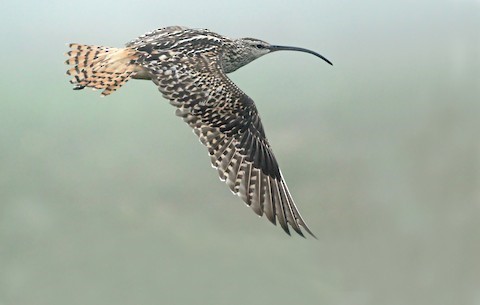Birdfinding.info ⇒ An unusual shorebird with a small, remote Alaskan breeding range and wintering grounds dispersed across far-flung Pacific archipelagos. The most accessible area where it can be found reliably is the northern tip of Oahu at James Campbell National Wildlife Refuge and the adjacent Kahuku Golf Course. In most if not all years, a few subadults remain during the breeding season, so it can be found there all year long. On the Big Island, the most consistent sites are Mauna Lani Golf Course at Puako and Kiholo Bay north of Kailua-Kona. There appear to be no consistent sites on Kauai or Maui, but one additional site where it is effectively resident in small numbers is Kaunakakai on Molokai. In Alaska, the most accessible area where breeding birds can be found consistently is in the interior of the Seward Peninsula along the Nome-Kougarok Road—especially in the Coffee Dome area around Mile 72. In mid-May, a few singles or small flocks regularly miss their targets and appear briefly elsewhere in Alaska, especially on the Pribilof Islands and around Homer.
Bristle-thighed Curlew
Numenius tahitiensis
Breeds in western Alaska. Winters on islands dispersed across the central Pacific.
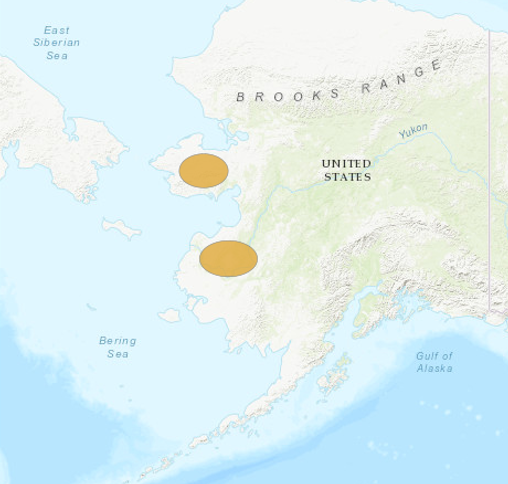
Approximate breeding range of the Bristle-thighed Curlew. © BirdLife International 2016
Breeding. Breeds from late May to July on hilly tundra, mainly at elevations of 50-500 m in the interior of the Seward Peninsula and in the Nulato Hills, northeast of St. Mary’s, just north of the Yukon-Kuskokwim Delta.
A 2001 estimate of the global population was approximately 3,500 breeding pairs plus about 3,000 nonbreeding subadults, most or all of which remain on the Pacific Islands. About 60% of the population breeds in the Nulato Hills and 40% on the Seward Peninsula.
Nonbreeding. Winters on oceanic islands throughout most of the tropical Pacific, from the Hawaiian Islands south across most of Micronesia and Polynesia.
Regularly occurs west to the Marianas, south to Fiji, Tonga, and the Cook Islands, and southeast regularly to the Pitcairn Islands, and at least occasionally to Easter Island.
About 800 to 1,000 have been found wintering in the Hawaiian Islands: 300-350 on Laysan; 300-400 on Lisianski; 100 on Midway; and the rest at a handful of sites on the main islands (mainly Oahu, Molokai, and the Big Island).
Other significant concentrations occur across a swath of Polynesia, in the Line, Marshall, Cook, Tuamotu, and Pitcairn archipelagos.
Movements. Northbound migrants arrive in Alaska in early to mid-May. Most fly directly from wintering grounds to breeding grounds, with small numbers appearing in May elsewhere in Alaska, and exceptionally along the western coast of the U.S. and Canada.
After breeding, most of the population gathers on nearby Bering Sea coasts from mid-June to late August, then fly directly to mid-Pacific islands.
A regular vagrant to south-coastal Alaska (especially Middleton Island), the Pribilofs, and the Alaska Peninsula. There are only a handful of records (most in May 1998) between Vancouver Island, British Columbia, and Point Reyes, California. It has also been recorded on several Japanese islands and on several distant shores of the South Pacific, including the Solomon Islands, the Kermadec Islands, Norfolk Island, Queensland, and Ecuador.
Identification
A medium-sized curlew, easily confused with Whimbrel, but with an unmarked buffy or cinnamon rump. (Cf. Whimbrel below for more details.)
On many adults, the warm-colored rump and tail contrast with otherwise mostly brown-and-gray plumage.
Immatures have bright buffy tones throughout much of their plumage, so the rump and tail do not contrast noticeably.
The common English name refers to thin, stiff, elongated feathers around the lower belly and thighs that usually require a close view to see clearly.
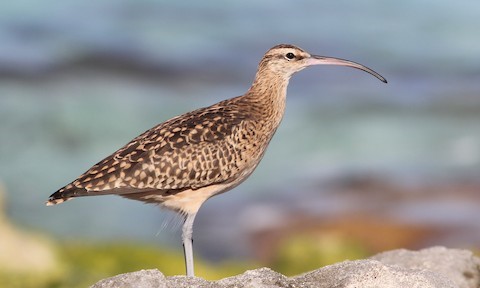
Bristle-thighed Curlew, showing “bristles” on thighs. (Laysan Island, Hawaii; February 26, 2012.) © Cameron Rutt
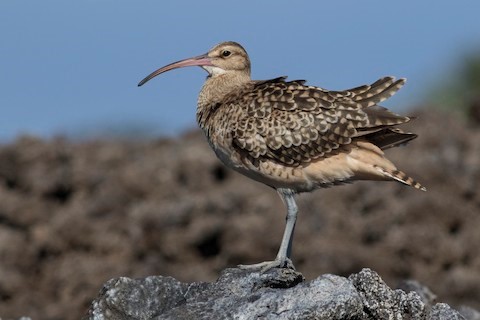
Bristle-thighed Curlew, showing pale buffy rump. (Mauna Lani Golf Course, Big Island, Hawaii; February 9, 2019.) © Jacob Drucker
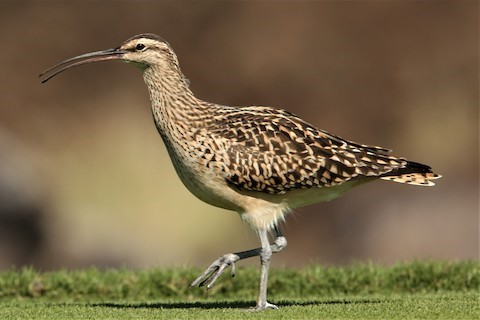
Bristle-thighed Curlew, showing “bristles” on thighs. (Mauna Lani Golf Course, Big Island, Hawaii; April 7, 2019.) © Aaron Maizlish
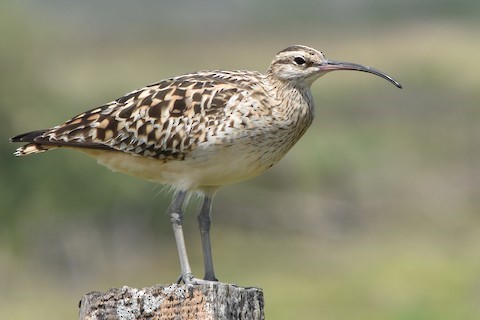
Bristle-thighed Curlew, showing “bristles” on thighs. (Kahuku Golf Course, Oahu, Hawaii; April 3, 2016.) © Michael Pang
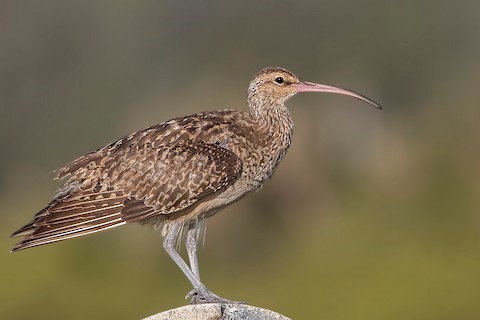
Bristle-thighed Curlew, showing “bristles” on thighs. (Kahuku Golf Course, Oahu, Hawaii; September 9, 2018.) © Bradley Hacker
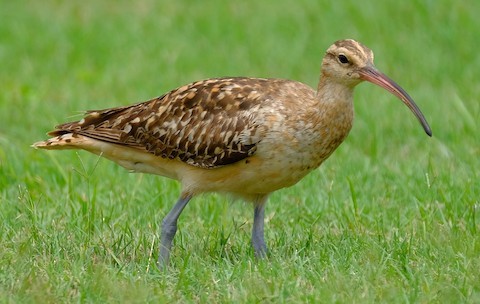
Bristle-thighed Curlew, immature showing patchy orange-buff in plumage. (Kahuku Golf Course, Oahu, Hawaii; September 15, 2018.) © David Zittin
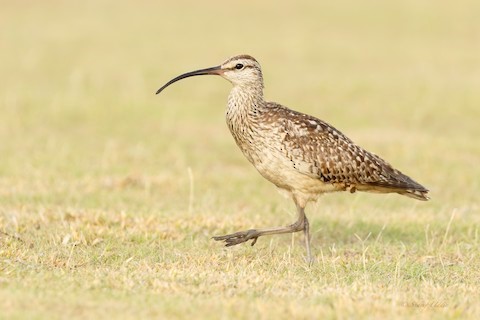
Bristle-thighed Curlew. (Kahuku Golf Course, Oahu, Hawaii; August 12, 2018.) © Sharif Uddin
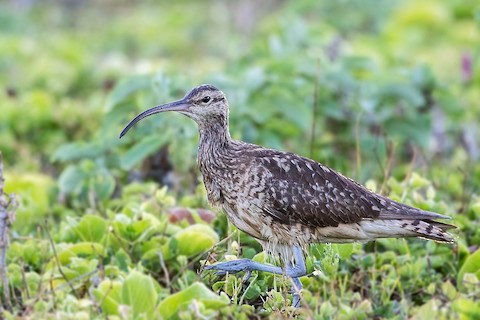
Bristle-thighed Curlew, showing “bristles” on thighs. (Kahuku Golf Course, Oahu, Hawaii; September 9, 2018.) © Bradley Hacker

Bristle-thighed Curlew. (Sand Island, Midway Atoll National Wildlife Refuge, Hawaii; February 26, 2019.) © Zeke Smith

Bristle-thighed Curlew, eating a crab. (Anchor Point, Alaska; May 20, 2013.) © Andrew Spencer
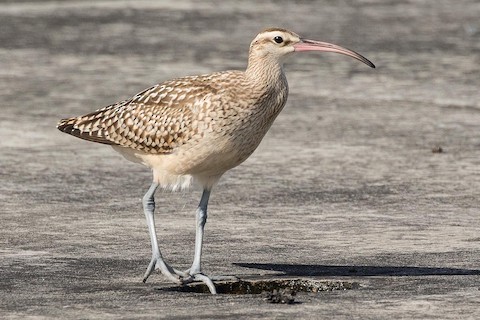
Bristle-thighed Curlew. (Sand Island, Midway Atoll National Wildlife Refuge, Hawaii; August 22, 2017.) © Eric VanderWerf

Bristle-thighed Curlew, likely subadult showing generally bright buffy plumage. (James Campbell National Wildlife Refuge, Oahu, Hawaii; February 20, 2020.) © Michael Young
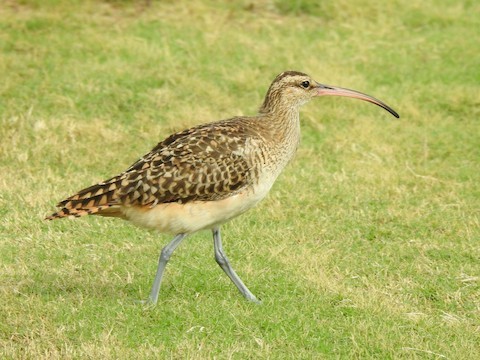
Bristle-thighed Curlew, likely subadult showing generally bright buffy plumage. (James Campbell National Wildlife Refuge, Oahu, Hawaii; January 11, 2020.) © Joel Glib
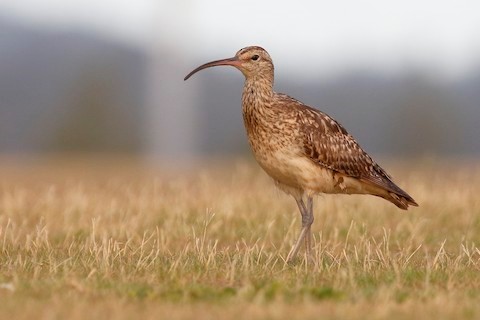
Bristle-thighed Curlew. (Kahuku Golf Course, Oahu, Hawaii; August 12, 2018.) © Sharif Uddin
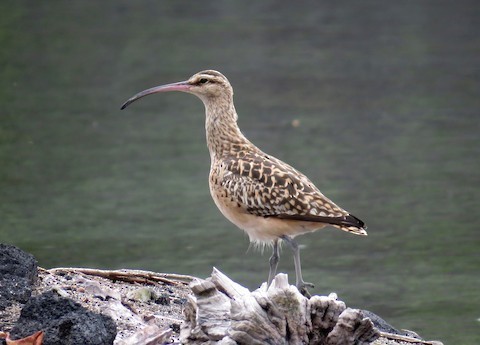
Bristle-thighed Curlew, showing “bristles” on thighs. (Kiholo Bay, Big Island, Hawaii; March 16, 2018.) © David Kidwell

Bristle-thighed Curlew. (Kiholo Bay, Big Island, Hawaii; March 27, 2017.) © Alan de Quieroz

Bristle-thighed Curlew—note buff-cinnamon tail with widely-spaced dark bands. (St. Paul Island, Alaska; May 23, 2018.) © Kenneth Trease

Bristle-thighed Curlew, showing buffy rump. (James Campbell National Wildlife Refuge, Oahu, Hawaii; January 20, 2018.) © Sharif Uddin

Bristle-thighed Curlew, showing buffy rump. (Anchor Point, Alaska; May 20, 2013.) © Andrew Spencer
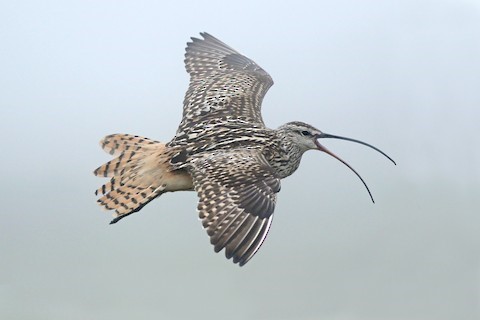
Bristle-thighed Curlew, showing contrast between brown-and-gray upperparts and buffy rump and tail. (Idaho Creek, Alaska; June 21, 2019.) © Jeremiah Trimble
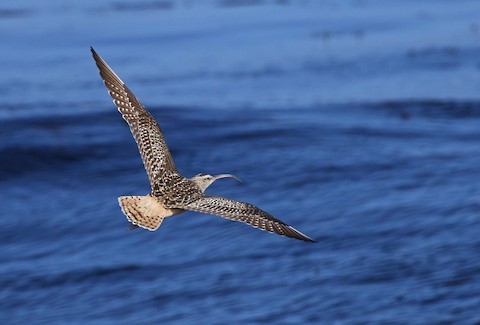
Bristle-thighed Curlew, showing contrast between brown-and-gray upperparts and buffy rump and tail. (St. Paul Island, Alaska; May 23, 2018.) © Kenneth Trease
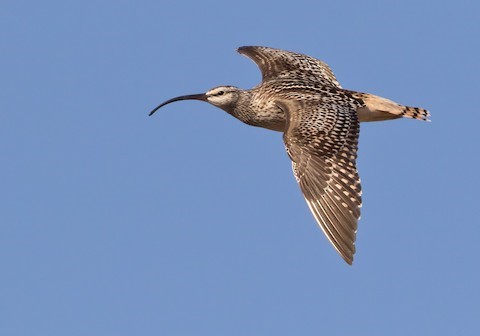
Bristle-thighed Curlew, showing buffy rump and only three dark bands on the tail. (Coffee Dome, Nome-Kougarok Road, Alaska; May 30, 2016.) © Lars Petersson
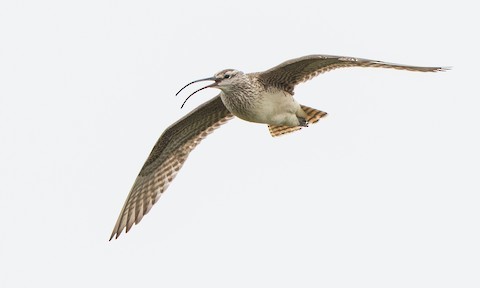
Bristle-thighed Curlew. (Mile 72, Nome-Kougarok Road, Alaska; June 29, 2019.) © Steve Kelling

Bristle-thighed Curlew, showing buffy rump. (Mile 72, Nome-Kougarok Road, Alaska; June 29, 2019.) © Steve Kelling
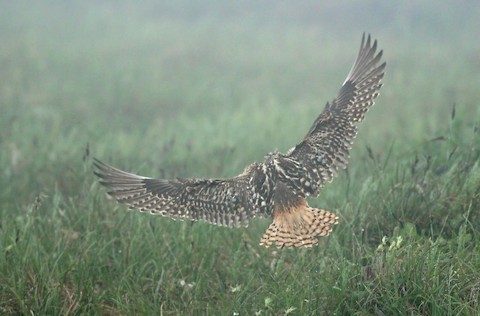
Bristle-thighed Curlew, showing contrast between brown-and-gray upperparts and buffy rump and tail. (Idaho Creek, Alaska; June 21, 2019.) © Jeremiah Trimble
Cf. Whimbrel. The three or four recognizably distinct forms of Whimbrel differ significantly among themselves, possibly enough to be subdivided into multiple species. Amid that visible diversity, the Bristle-thighed Curlew resembles the “American Whimbrel” more closely than either of them resembles the Old World Whimbrel forms. “American Whimbrel” and Bristle-thighed Curlew occur together regularly in Alaska and less often elsewhere around the Pacific region, and their strong similarity likely results in some Bristle-thighs going undetected.
The differences within each species due to individual variation, molt-stage and age-class generally swamp most visible distinctions between them, leaving only two readily observed differences that are entirely reliable: voice and the predominant color of the rump and tail.
Voice: The contact calls of all Whimbrel forms are staccato trills of sharp, evenly-spaced notes. The Bristle-thighed Curlew’s common contact call is a distinctive two-note whistle, CHIU-EET!, and its song is an elaborately phrased series of whistles.
Rump and Tail Color: While its coloration elsewhere varies widely, the Bristle-thighed Curlew’s rump and tail are always bright buffy or cinnamon, the rump is unmarked, and the tail shows three to five widely-spaced dark bands. In contrast, the “American Whimbrel’s” rump and tail are heavily marked and appear mostly dark-brown.
Notes
Monotypic species.
IUCN Red List Status: Vulnerable.
References
Alderfer, J., and J.L. Dunn. 2014. National Geographic Complete Birds of North America (Second Edition). National Geographic Society, Washington, D.C.
BirdLife International. 2016. Numenius tahitiensis. The IUCN Red List of Threatened Species 2016: e.T22693182A95218288. https://dx.doi.org/10.2305/IUCN.UK.2016-3.RLTS.T22693182A95218288.en. (Accessed June 27, 2020.)
eBird. 2020. eBird: An online database of bird distribution and abundance. Cornell Lab of Ornithology, Ithaca, N.Y. http://www.ebird.org. (Accessed June 27, 2020.)
Hayman, P., J. Marchant, and T. Prater. 1986. Shorebirds: An Identification Guide. Houghton Mifflin, Boston.
Marks, J.S., T.L. Tibbitts, R.E. Gill, and B.J. McCaffery. 2002. Bristle-thighed Curlew (Numenius tahitiensis). In The Birds of North America, No. 705 (A. Poole and F. Gill, eds.) The Birds of North America, Inc., Philadelphia.
Pratt, H.D., P.L. Bruner, and D.G. Berrett. 1987. A Field Guide to the Birds of Hawaii and the Tropical Pacific. Princeton University Press.
Pratt, H.D. 1993. Enjoying Birds in Hawaii: A Birdfinding Guide to the Fiftieth State (Second Edition). Mutual Publishing, Honolulu, Hawaii.
Pyle, R.L., and P. Pyle. 2017. The Birds of the Hawaiian Islands: Occurrence, History, Distribution, and Status. Version 2 (January 1, 2017). http://hbs.bishopmuseum.org/birds/rlp-monograph/. B.P. Bishop Museum, Honolulu, Hawaii.
Xeno-Canto. 2020. Bristle-thighed Curlew – Numenius tahitiensis. https://www.xeno-canto.org/species/Numenius-tahitiensis. (Accessed June 27, 2020.)
